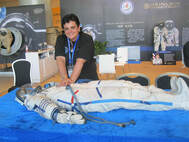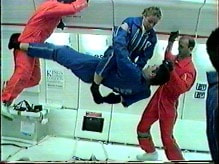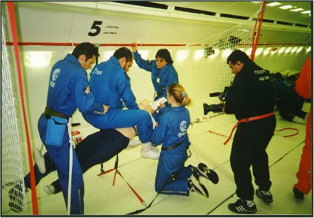|
Cardiopulmonary resuscitation (CPR) is a well-established part of basic life support (BLS), having saved countless lives since its first development in the 1960s. External chest compressions (ECCs), which form the main part of BLS, must be carried out until Advanced Life Support can begin. It is essential that ECCs are performed to the correct depth and frequency to guarantee effectiveness. The absence of gravity during spaceflight means that performing ECCs is more challenging. The likelihood of a dangerous cardiac event occurring during a space mission is remote, however, the possibility does exist. Nowadays, the selection process for space missions considers individuals at ages and with health standards that would have prohibited their selection in the past. With increased age, less stringent health requirements, longer duration missions and increased physical labour, due to a rise in orbital extravehicular activity, the risk of an acute life-threatening condition occurring in space has become of greater concern. The advent of space tourism may even enhance this possibility, with its popularity set to rise over the coming years as private companies test their new technology. Therefore, space scientists and physicians will have a greater responsibility to ensure space travellers, whether professional astronauts or space tourists, are adequately trained and familiarised with extraterrestrial BLS and CPR methods. Recently, work has been undertaken to develop methods of basic and advanced life support in microgravity and hypogravity, and several CPR techniques have been developed and tested. This blog presents one of these, the Evetts-Russomano MicroG CPR Method. Evetts-Russomano MicroG CPR Method In the Evetts-Russomano (ER) method, the rescuer can respond immediately, as it requires no additional CPR equipment/medication or the use of a restraint system. To assume the position, the rescuer places their left leg over the right shoulder of the patient and their right leg around the patient’s torso, allowing their ankles to be crossed approximately in the centre of the patient’s back; this is to provide stability and a solid platform against which to deliver force, without the patient being pushed away. From this position, chest compressions can be performed while still retaining easy access to perform ventilation. When adopting the ER CPR method, the rescuer must be situated in a manner that also allows sufficient space on the patient’s chest for the correct positioning of their hands to deliver the chest compressions. Extraterrestrial CPR simulation The main difference between extraterrestrial and terrestrial CPR is the strength of the gravitational field. In microgravity, patient and rescuer are both essentially weightless. When thinking about the technique of terrestrial CPR, with the rescuer accelerating their chest and upper body to generate a force to compress the patient’s chest, it is obvious that this cannot work in microgravity without significant aids. To this end, the ER CPR method has been developed using a ground-based microG simulation, during parabolic flights, and subsequently tested under-water! Video credits: Ground-based MicroG Simulation (land) = Space Researcher Lucas Rehnberg, MD (MicroG Center PUCRS, Brazil) Parabolic Flight MicroG Simulation (air)= Researchers = Thais Russomano, Simon Evetts, Lisa Evetts & João Castro (ESA 29th Parabolic Flight Campaign, Bordeaux, France) Underwater MicroG Simulation (water) = Sea King Dive Center, Chengdu, China - Instructor Gang Wei; Chinese Space First Responder & Space Researcher/Instructor Chris Yuan A project of InnovaSpace, PECA and Guangxi Diving Paradise Club, China Free Resource: Extraterrestrial CPR and Its Applications in Terrestrial Medicine
Authors: Thais Russomano, Lucas Rehnberg In book: Resuscitation Aspects, Ed: Theodoros Aslanidis Publisher: IntechOpen 2017 See Download Link at https://www.innovaspace.org/chapters.html Comments are closed.
|
Welcometo the InnovaSpace Knowledge Station Categories
All
|
InnovaSpace Ltd - Registered in England & Wales - No. 11323249
UK Office: 88 Tideslea Path, London, SE280LZ
Privacy Policy I Terms & Conditions
© 2024 InnovaSpace, All Rights Reserved
UK Office: 88 Tideslea Path, London, SE280LZ
Privacy Policy I Terms & Conditions
© 2024 InnovaSpace, All Rights Reserved




 RSS Feed
RSS Feed